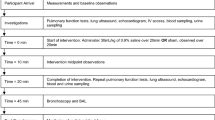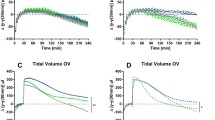Abstract
Four groups of anesthetized, ventilated dogs (n=6 in each group) inoculated endotracheally withPseudomonas aeruginosa were studied over 5 h as bilateral, hemorrhagic pneumonia developed. Groups I and II were ventilated with zero end-expiratory pressure (ZEEP) and groups III and IV with positive end-expiratory pressure (PEEP) (8 cmH2O). Hetastarch (6%) in saline was infused intravenously to maintain similar transmural pulmonary wedge pressures (Pwtm) in groups I and III (approximately 5 mmHg) and groups II and IV (approximately 10 mmHg) throughout the experiment. The effects of plasma volume expansion were analyzed by comparing groups I and III with groups II and IV and of PEEP by comparing groups I and II with groups III and IV. The number of lobes with gross consolidation was greater in groups II (4.8±1.2) and IV (5±0.9) than in groups I (2±1.1) and III (3.3±1). The mean lung wet weight/body weight ratio was greater in groups II (40±11 g/kg) and IV (48±12 g/kg) than in groups I (19±3 g/kg) and III (32±6 g/kg) and in groups III and IV than in groups I and II. Plasma volume expansion, in the absence of PEEP (group II vs. group I), dramatically increased intrapulmonary shunt (Qs/Qt 5 h after inoculation: group II, 62±13%; group I, 25±12%). However, overall gas exchange 5 h after inoculation was not significantly different between PEEP-treated groups and ZEEP-treated groups despite more extensive disease in the former. Despite maintenance of Pwtm, cardiac output fell significantly over the 5 h study period in groups III (4.3±0.7 to 3.3±1.0 L/min) and IV (7.2±1.7 to 3.8±2.4 L/min) compared to groups I (3.8±1.0 to 3.5±1.2 L/min) and II (6.9±3.2 to 7.3±2.6 L/min). We conclude that plasma volume expansion, within the normal physiological range of Pwtm, increases the extent of pneumonia. Positive end-expiratory pressure with maintenance of Pwtm also independently increases pneumonia size, possibly by increasing pulmonary capillary hydrostatic pressure, but masks this effect by maintaining arterial oxygenation through recruitment of additional lung units for gas exchange. The data also suggest that PEEP adversely affects cardiac performance in this model of acute pneumonia.
Similar content being viewed by others
References
Ashbaugh DG, Bigelow DB, Petty TL, Levine BE (1967) Acute respiratory distress in adults. Lancet 2:319–323
Benson H, Akbarian M, Adler LN, Abelmann WH (1970) Hemodynamic effects of pneumonia: normal and hypodynamic responses. J Clin Invest 49:791–798
Brigham K, Bowers R, Haynes J (1979) Increased sheep lung vascular permeability caused byE. coli endotoxin. Circ Res 45:292–297
Brigham KL, Woolverton WC, Blake LH, Staub NS (1974) Increased sheep lung vascular permeability caused by pseudomonas bacteremia. J Clin Invest 54:729–804
Cooligan T, Light RB, Wood LDH, Mink SN (1982) Plasma volume expansion in canine pneumococcal pneumonia: its effects on respiratory gas exchange and pneumonia size. Am Rev Respir Dis 126:86–91
Craven KD, Oppenheimer L, Wood LDH (1974) Effects of contusion and flail chest on pulmonary perfusion and oxygen exchange. J Appl Physiol 47:729–737
Demling RH, Staub NC, Edmunds LH Jr (1975) Effect of end-expiratory airway pressure on accumulation of extravascular lung water. J Appl Physiol 38(5):907–912
Fetzer AE, Werner AS, Hagstrom JWC (1967) Pathologic features of pseudomonal pneumonia. Am Rev Respir Dis 96(6):1121–1130
Hales CA, Sonne L, Peterson M, Kong D, Miller M, Watkins WD (1981) Role of thromboxane and prostacyclin in pulmonary vasomotor changes after endotoxin in dogs. J Clin Invest 68:499–505
Hanly P, Light RB (1987) Effect of PEEP on gas exchange, pulmonary perfusion and hemodynamics in a canine model of diffuse pseudomonas pneumonia. J Crit Care 2(3):187–193
Hanly P, Light RB (1987) Lung mechanics, gas exchange, pulmonary perfusion, and hemodynamics in a canine model of acute pseudomonas pneumonia. Lung 165:305–322
Holloway H, Perry M, Downey J, Parker J, Taylor A (1983) Estimation of effective pulmonary capillary pressure in intact lungs. J Appl Physiol 54(3):846–851
Kirk BW, Raber MB (1973) A practical apparatus for rapid determination of blood oxygen content. J Appl Physiol 34:724–725
Kumar R, Wallace WA, Ramirez A, Benson H, Abelmann WH (1970) Hypodynamic effects of pneumonia: expansion of plasma volume. J Clin Invest 49:799–805
Leftwich IE, Witorsch RJ, Witorsch P (1973) Positive end-expiratory pressure in refractory hypoxemia. Ann Intern Med 44:187–193
Light RB, Mink SN, Cooligan TG, Wood LDH (1983) Physiology of recovery in experimental pneumococcal pneumonia. Clin Invest Med 6(3):147–151
Light RB, Mink SN, Wood LDH (1981) Pathophysiology of gas exchange and pulmonary perfusion in pneumococcal lobar pneumonia in dogs. J Appl Physiol 50(3):524–530
Lynch JP, Mhyre JG, Dantzker DR (1979) Influence of cardiac output on intrapulmonary shunt. J Appl Physiol 46(2):315–321
Marshall BE, Marshall C (1980) Continuity of response to hypoxic pulmonary vasoconstriction. J Appl Physiol 49(2):189–196
Pennington JE, Reynolds HY, Carbone PP (1973) Pseudomonas pneumonia: a retrospective study of 36 cases. Am J Med 55:155–160
Pepe PE, Hudson LD, Carrico CJ (1984) Early application of positive end-expiratory pressure in patients at risk for the adult respiratory-distress syndrome. N Engl J Med 311(5):281–286
Pierce AK, Sanford JP (1974) State of the art: aerobic gram-negative bacillary pneumonias. Am Rev Respir Dis 110:647–658
Prewitt R, McCarthy J, Wood LDH (1981) The treatment of acute low pressure pulmonary edema in dogs. Relative effects of hydrostatic and oncotic pressures, nitroprusside and positive end-expiratory pressure. J Clin Invest 67:409–418
Rossing RG, Cain SM (1966) A nomogram relating PO2, pH, temperature and hemoglobin saturation in the dog. J Appl Physiol 21:195–201
Sokal RR, Rahlf FJ (1981) Biometry, 2nd ed. W.H. Freeman, New York
Staub NC (1978) Pulmonary edema due to increased microvascular permeability to fluid and protein. Circ Res 48:143–151
Tillotson JR, Lerner AM (1966) Pneumonias caused by gram negative bacilli. Medicine 45(1):65–76
Tilson MD, Bunke MC, Walker Smith GJ, Katz J, Cronau L, Barash PG, Baue AE (1977) Quantitative bacteriology and pathology of the lung in experimental Pseudomonas pneumonia treated with positive end-expiratory pressure (PEEP). Surgery 82(1):133–140
Toung T, Saharia P, Permutt S, Zuidema GD, Cameron JL (1977) Aspiration pneumonia: beneficial and harmful effects of positive end-expiratory pressure. Surgery 82(2):279–283
Von Euler VS, Liljestrand G (1946) Observations on the pulmonary arterial blood pressure in the cat. Acta Physiol Scand 12:301–320
Weil MH, Nishijima H (1978) Cardiac output in bacterial shock. Am J Med 64:920–922
Author information
Authors and Affiliations
Rights and permissions
About this article
Cite this article
Hanly, P., Light, R.B. Plasma volume expansion and PEEP in a canine model of acutePseudomonas pneumonia. Lung 167, 285–299 (1989). https://doi.org/10.1007/BF02714958
Accepted:
Issue Date:
DOI: https://doi.org/10.1007/BF02714958




